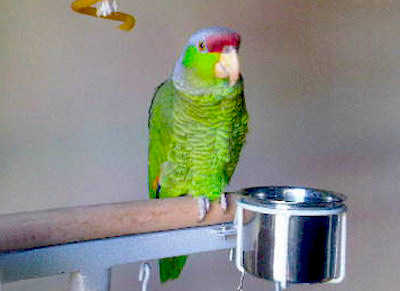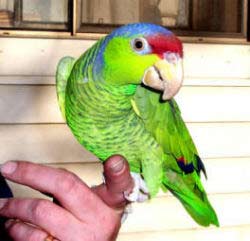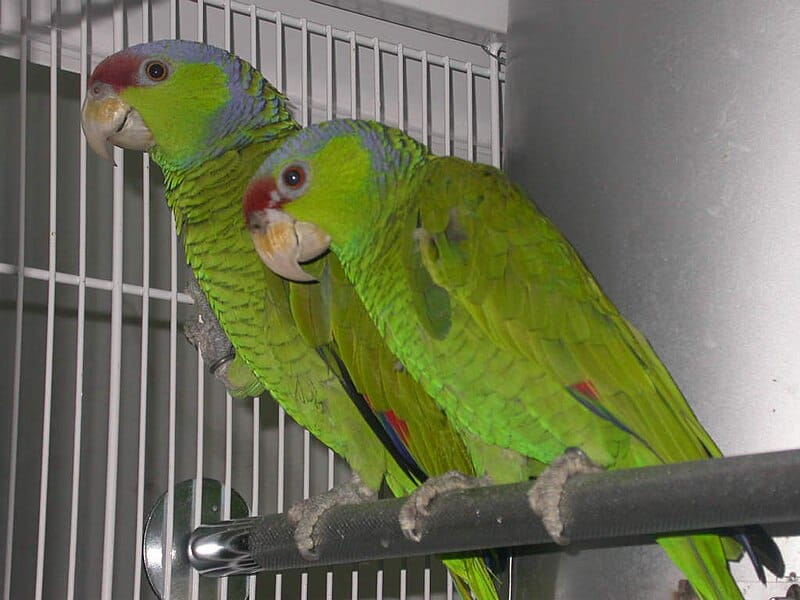
The Lilac-crowned Amazon is a smaller amazon, but makes up in energy what it lacks in size!
The Lilac-crowned Amazon Amazona finschi is also known as Finsch’s Amazon. It has been recognized for well over 100 years, documented as early as 1864 by Dr. Otto Finsch. Dr. Finsch wrote well over 400 works on ornithology and this beautiful little amazon parrot is named for him.
The name Lilac-crowned comes from its looks. This is one of the smaller amazons reaching about 13″ (33 cm) long, but a very colorful bird. The “lilac” namesake comes the pretty lilac colored crown accented by a red brown forehead and lores. The lilac extends onto the neck and circles around its yellow-green cheeks.
An Amazon bird with similar type markings and color is the Green-cheeked Amazon A. viridigenalis, yet in comparison each has its unique color and pattern distinctions. The red on Lilac-crowned Amazon is a bit darker and doesn’t extend past the eyes. On the Green-cheeked, the red extends past the eyes onto the crown in varying amounts. The Lilac-crowned also has more dramatic appearance to its chest feathering. Edged in black, the feathers look scalloped while the Green-cheek’s are more uniform.
This dynamic little amazon is a fair talker and makes a fine pet. But though the Lilac-crowned Amazon is affectionate and clever, it is also very lively. This active, energetic birdneeds lots of activities and will do best spending a good portion of its time outside of its cage where it can climb, play, and fly for exercise. They do very well in an aviary which gives them more room on a regular basis.
Like most amazons the Finsch’s Amazon is very social, enjoying the companionship of people as well as other amazons. They make a wonderful companion and will quickly form a strong bond with their owner.
For more information about Amazon Birds see:
Amazon Parrot: Information and Care
- Kingdom: Animalia
- Phylum: Chordata
- Class: Aves
- Order: Psittaciformes
- Family: Psittacidae
- Genus: Amazona
- Species: finschi
Scientific name
Amazona finschi – Subspecies:
- Lilac-crowned Amazon – common species
Amazona finschi finschi - Sonora Lilac-crowned Amazon – rarer subspecies; slightly larger, somewhat duller in color, and a narrower forehead.
Amazona finschi woodi
Distribution
The Lilac-crowned Amazon Amazona finschi was first described by Sclater in 1864. It is also known as Finsch’s Amazon, named by Dr. P.L. Sclater in honor of Dr. Otto Finsch, who documented this Amazon and wrote over 400 works on ornithology.
It is native to the Pacific slopes of Western Mexico. In the wild they live in large flocks, sometimes several hundreds of these birds massed closely together. These flocks are quite conspicuous and noisy. They inhabit wooded foothills and mountains, plains, grain fields, and banana plantations. They feed on wild figs, berries, seeds, nuts, and the blossoms and leafy buds of treetop foliage.
Status
The Amazona finschi is on the IUCN Red List for Endangered Species as Vulnerable (VU).
Description
The Lilac-crowned Amazon or Finsch’s Amazon has green plumage though more yellow on the underparts. The feathers of the neck and upper sides are edged in black giving it a scalloped appearance that resembles an African Gray. The forehead and lores back to the eyes are a red brown. There is a blue mauve on the crown and neck making a half moon shape around the cheeks, which are a yellowish-green. The outer feathers of the wings are edged in a violet blue, there is a red speculum, and the tail is tipped with a yellow-green. The eye is orange, the beak is horn-colored, and the legs are greenish-gray.
Juveniles are similar to the adults but their eyes are dark brown. Mature birds are about 13 inches (33 cm) long from the head to the tip of the tail. The average lifespan of the Lilac-crowned Amazon or Finsch’s Amazon is 40 to 60 years.
Care and feeding
In the wild these birds eat fruits (they are especially fond of figs), seeds, nuts, berries, blossoms, corn, and bananas. A pet bird will enjoy a varied diet, including a quality seed mix or a pelleted diet, and many fresh fruits and vegetables. Pellets will work if started at an early age. Plenty of human food that is nutritious can be offered. Avocado and chocolate are toxic to any parrot.
For more about the Amazon parrot diet, see Amazon Parrots: Care and Feeding
Housing
A roomy cage is required for the Lilac-crowned Amazon as they are very active. They need to spend a good deal of their time outside of their cage or be housed in an aviary. The cage must not be too confining, so get one that your pet will be able to feel comfortable in. It is recommended that a cage be 2 x 3 feet wide and 2 1/2 to 5 feet high, and with a play pen top.
They love to be out of their cage on a playpen, and will enjoy interacting with their human as well as playing with toys. This parrot likes to climb and play, and enjoys expanding its wings. A great thing to have is a hanging perch above a playpen topped cage, for climbing.
The Finsch’s Amazon can tolerate varying temperatures, but needs to be kept away from any drafts. A variety of perches should be used of varying size and texture. A rougher textured perch instead of the smooth, doll-rod types, makes it easier for them to perch and is better for their feet and legs. A concrete perch can be placed as the highest perch in the cage and next to a toy. At times during the day they will perch there and it will save them (and you) from the ordeal of having their nails filed.
Don’t forget bathing. Spraying your amazon with warm water or a commercially available bird bath is necessary to keep the feathers from drying out. Learn to have fun during bath time. Whether you spritz your amazon with water or an aloe spritz, or just put him in the kitchen sink, make it fun. Your amazon will teach you how he likes to be bathed.
Maintenance
The basic cage care includes daily cleaning of the water and food dishes. Weekly you should wash all the perches and dirty toys, and the floor should be washed about every other week. A total hosing down and disinfecting of an aviary should be done yearly, replacing anything that needs to be freshened, such as old dishes, toys and perches
Social Behaviors
In the wild, Lilac-crowned Amazons gather in large flocks of two or three hundred birds, except during breeding season. They also form permanent pairs when they are sexually mature. These parrots enjoy human interaction as well as interaction with other birds. They like to be greeted when you come into the room. The more your amazon is around people, the more socialized it is and the more it will interact and play with you. You will establish a greater attachment between you and your feathered friend the more you are together.
 Lilac-crowned Amazon Photo Courtesy Jamie Wertz, The Tweetery
Lilac-crowned Amazon Photo Courtesy Jamie Wertz, The TweeteryHandling/Training
The Lilac-crowned Amazon will adapt fairly rapidly, becoming accustomed to a new environment and its keeper. It is then ready to start bird training. Generally though, you should give a new arrival a few days to get use to you, your voice and its cage before trying to handle it. A hand fed baby will not need much taming and can often be handled right away, as it is use to human attention.
For information about training your Blue Front parrot see: Amazon Parrot Care: Handling and Training
Activities
The Lilac-crown is a very active amazon. It needs a lot of time out of its cage to stretch its wings, although climbing seems to be its favorite activity. It needs plenty of toys to keep it busy, and a hanging perch is thoroughly enjoyed. A moveable perch that can follow you around the house is also great. This Amazon likes to play, loves to wrangle with toys, and is quite an acrobat. They entertain themselves quite well and you will enjoy it.
Sexing – Sexual Differences
Lilac-crowned Amazons or Finsch’s Amazons are not sexually dimorphic, females look like males. If gender identification is important (for example for breeding birds) DNA / Feather or surgical sexing is recommended.
Breeding/Reproduction
These Amazons are commonly bred in captivity, and have been for a number of years. One early breeding success related by Rosemary Low, was accomplished by Mrs. F. Hubbel in San Diego as early as 1954. The Lilac-crowned Amazon or Finsch’s Amazon are sexually mature at around 5 years old, but the sexes must be confirmed and the pair must be harmonious, bonded with each other. They will need a nest box that is 31″-39″ (80-100 cm) high with an inside diameter of 12″-14″ (30-35 cm) and an opening of 4″-5″ (10-12 cm). Provide some soft bedding material inside on the bottom of the box.
At the onset of warm weather (April to early May) courtship will begin. The hen will then lay three eggs which incubate for about 26 – 28 days. The young will leave the nest at about 8 weeks. As with many parrots, the male will eat for both himself and the female while she incubates the eggs and feeds the young. The male regurgitates the food for the female to eat. He gets a lot less picky about what he eats at these times!
Potential Problems
The Lilac-crowned Amazon or Finsch’s Amazon can be noisy early in the morning and when the sun is setting. This usually lasts for about 10 minutes. It is just waking up and letting you know it is up or getting ready for bed. These parrots when well cared for will seldom become ill. Though it is often difficult to determine illness, some visible signs of illness to be aware of are:
- ruffled plumage
- listlessness
- drooping wings
- sagging body
- extreme mood changes
- having no appetite
- bulges in feathering
- partially closed or watery eyes
- swelling of the eyelids
- rasping
- difficulty breathing
- excessive saliva
- dirty vent
- any change in the feces not apparently diet related.
Some of the more common illnesses are:
- Psittacosis (chlamydiosis or parrot fever)
- bacterial, viral, or fungal infections
- feather picking (results of boredom, poor diet, sexual frustration, lack of bathing)
- allergies
- chewing flight and tail feathers by juveniles
- beak malformations in chicks
- Papillomas
- kidney disease (gout)
- toxicity
- heavy metal poisoning
- lipomas in older birds.
If you notice any of these bird illnesses in your Lilac-crowned Amazon, immediately provide a warm, draft free, secure environment kept at about 86°F (30°C). Place food and water close to the perch where it is easily accessible. An ailing parrot should be taken to a avian veterinarian for diagnosis and treatment.
Availability
The Lilac-crowned Amazon or Finsch’s Amazon is readily available and it should be easy to find one in a pet store or from breeders in your area.
References
- Animal-World References: Pet Birds – Exotic Birds
- Dr. David Alderton, The Atlas of Parrots of the World, T.F.H. Publications, Inc. 1991
- David Alderton,, A Bird Keeper’s Guide to Parrots and Macaws, Salamander Books, 1989
- David Alderton, Parrots, Salamander Books, 1999
- Arthur Freud, All About The Parrots, Howell Book House, 1986
- Werner and Susanne Lantermann, Amazon Parrots, Barron’s Educational Series, Inc. 1988
Amazona finschi (Image Credit: TJ Lin, Wikimedia Commons CC BY-SA 2.0 Generic)
